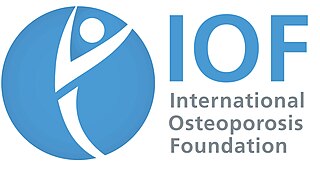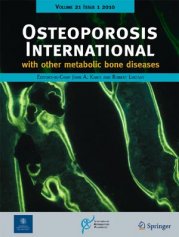
Osteoporosis is a systemic skeletal disorder characterized by low bone mass, micro-architectural deterioration of bone tissue leading to bone fragility, and consequent increase in fracture risk. It is the most common reason for a broken bone among the elderly. Bones that commonly break include the vertebrae in the spine, the bones of the forearm, and the hip. Until a broken bone occurs there are typically no symptoms. Bones may weaken to such a degree that a break may occur with minor stress or spontaneously. After the broken bone heals, the person may have chronic pain and a decreased ability to carry out normal activities.

Bisphosphonates are a class of drugs that prevent the loss of bone density, used to treat osteoporosis and similar diseases. They are the most commonly prescribed drugs used to treat osteoporosis. They are called bisphosphonates because they have two phosphonate groups. They are thus also called diphosphonates.

Teriparatide, sold under the brand name Forteo, is a form of parathyroid hormone (PTH) consisting of the first (N-terminus) 34 amino acids, which is the bioactive portion of the hormone. It is an effective anabolic agent used in the treatment of some forms of osteoporosis. Teriparatide is a recombinant human parathyroid hormone analog. It has an identical sequence to the 34 N-terminal amino acids of the 84-amino acid human parathyroid hormone.

Zoledronic acid, also known as zoledronate and sold under the brand name Zometa by Novartis among others, is a medication used to treat a number of bone diseases. These include osteoporosis, high blood calcium due to cancer, bone breakdown due to cancer, Paget's disease of bone and Duchenne muscular dystrophy (DMD). It is given by injection into a vein.

Osteopenia, known as "low bone mass" or "low bone density", is a condition in which bone mineral density is low. Because their bones are weaker, people with osteopenia may have a higher risk of fractures, and some people may go on to develop osteoporosis. In 2010, 43 million older adults in the US had osteopenia. Unlike osteoporosis, osteopenia does not usually cause symptoms, and losing bone density in itself does not cause pain.

Bone density, or bone mineral density, is the amount of bone mineral in bone tissue. The concept is of mass of mineral per volume of bone, although clinically it is measured by proxy according to optical density per square centimetre of bone surface upon imaging. Bone density measurement is used in clinical medicine as an indirect indicator of osteoporosis and fracture risk. It is measured by a procedure called densitometry, often performed in the radiology or nuclear medicine departments of hospitals or clinics. The measurement is painless and non-invasive and involves low radiation exposure. Measurements are most commonly made over the lumbar spine and over the upper part of the hip. The forearm may be scanned if the hip and lumbar spine are not accessible.

Quantitative computed tomography (QCT) is a medical technique that measures bone mineral density (BMD) using a standard X-ray Computed Tomography (CT) scanner with a calibration standard to convert Hounsfield Units (HU) of the CT image to bone mineral density values. Quantitative CT scans are primarily used to evaluate bone mineral density at the lumbar spine and hip.

Ibandronic acid is a bisphosphonate medication used in the prevention and treatment of osteoporosis and metastasis-associated skeletal fractures in people with cancer. It may also be used to treat hypercalcemia. It is typically formulated as its sodium salt ibandronate sodium.

Denosumab is a human monoclonal antibody for the treatment of osteoporosis, treatment-induced bone loss, metastases to bone, and giant cell tumor of bone.
The American Society for Bone and Mineral Research (ASBMR) is a professional, scientific and medical society established in 1977 to promote excellence in bone and mineral research and to facilitate the translation of that research into clinical practice. The ASBMR has a membership of nearly 4,000 physicians, basic research scientists, and clinical investigators from around the world.

The Royal Osteoporosis Society (ROS), formerly the National Osteoporosis Society, established in 1986, is the only UK-wide charity dedicated to improving the prevention, diagnosis and treatment of osteoporosis. It is based in Camerton, Somerset, England.
Richard Eastell MD, FRCP, FRCPath, FMedSci is a British medical doctor and Professor of Bone Metabolism at the University of Sheffield. He was born in Shipley and attended the Salt Grammar School, later graduating from the University of Edinburgh in 1977 with an MB ChB and in 1984 with an MD and achieved prominence as an expert in osteoporosis.

The International Osteoporosis Foundation (IOF), headquartered in Nyon, Switzerland, is a non-governmental organization (NGO) founded in 1998. It was formed from the merger of the European Foundation for Osteoporosis, founded in 1987, and the International Federation of Societies on Skeletal Diseases. The foundation functions as a global alliance of individuals and organizations concerned with the prevention, diagnosis and treatment of osteoporosis and musculoskeletal bone disease. The goal of the Foundation is to increase the early detection of osteoporosis and related musculoskeletal diseases, as well as to improve the treatment of these conditions through international collaboration among national healthcare systems and governments. The Foundation is the largest global NGO dedicated to osteoporosis and musculoskeletal diseases.

Calcified Tissue International is a peer-reviewed medical journal published by Springer Science+Business Media and first launched in 1967. From 1967 to 1978, the journal was published under the name Calcified Tissue Research. It is an official journal of the International Osteoporosis Foundation. The journal is published monthly and includes original research on the structure and function of bone and other mineralized systems in living organisms, as well as reviews and special reports.

Osteoporosis International is a peer-reviewed medical journal published by Springer Science+Business Media. The journal was launched in 1990. It is an official journal of the International Osteoporosis Foundation and the National Osteoporosis Foundation. The journal is published monthly and includes original research on all areas of osteoporosis and its related fields, alongside reviews, educational articles, and case reports.
FRAX is a diagnostic tool used to evaluate the 10-year probability of bone fracture risk. It was developed by the University of Sheffield. FRAX integrates clinical risk factors and bone mineral density at the femoral neck to calculate the 10-year probability of hip fracture and the 10-year probability of a major osteoporotic fracture. The models used to develop the FRAX diagnostic tool were derived from studying patient populations in North America, Europe, Latin America, Asia and Australia.

World Osteoporosis Day is observed annually on 20 October, and launches a year-long campaign dedicated to raising global awareness of the prevention, diagnosis and treatment of osteoporosis and metabolic bone disease. Organized by the International Osteoporosis Foundation (IOF), the World Osteoporosis Day campaign is accompanied by community events and local campaigns by national osteoporosis patient societies from around the world with activities in over 90 countries.
Osteogenic loading (OL) is a rehabilitative exercise method with the goal of improving bone density and preventing bone fracture. This may be seen as brief, intensive, resistance exercise for bone health.
Ambrish Mithal is an Indian endocrinologist and the Chairman and Head of Endocrinology and Diabetes at Max Healthcare- Pan-Max, Saket, New Delhi, where he started working in December 2019. He secured the master's degree (DM) from the All India Institute of Medical Sciences, New Delhi, and subsequently worked at Sanjay Gandhi Post Graduate Institute of Medical Sciences, Lucknow and, later, at Apollo Hospitals, New Delhi before joining Medanta the Medicity as Chairman, Division of Endocrinology and Diabetes where he worked from 2009 to 2019. Mithal was honoured by the Government of India in 2015 with Padma Bhushan, the third highest Indian civilian award, for his outstanding contribution to the field of medicine. In September 2020 Dr Mithal became the first Indian to be chosen for the Laureate Award for International Excellence in Endocrinology (2021) by the Endocrine Society (US).
Endocrine & Metabolism Research Institute (EMRI) is one of Tehran University of Medical Sciences research institute and a pioneering institute with a mission to combine clinical care, research, and education in diabetes, endocrine and metabolic diseases.














